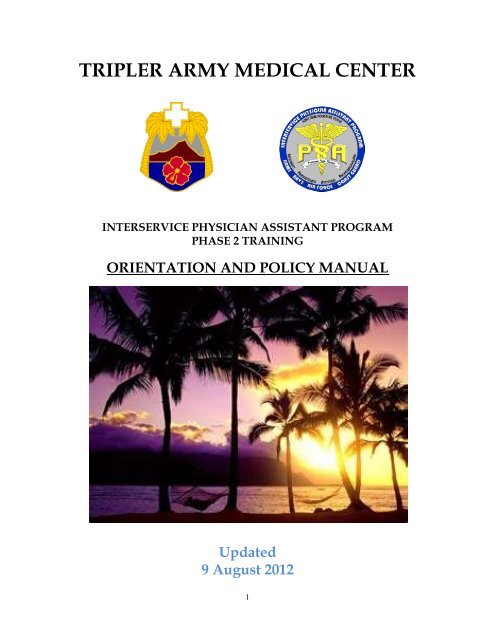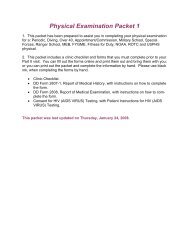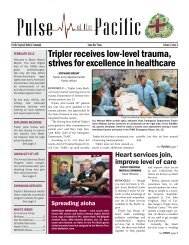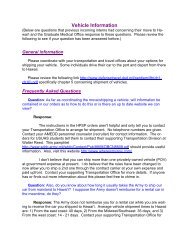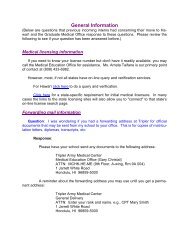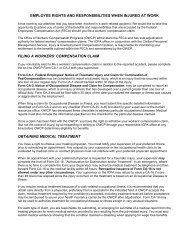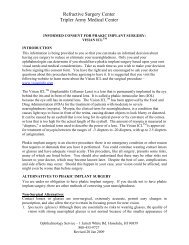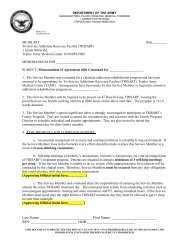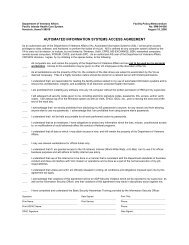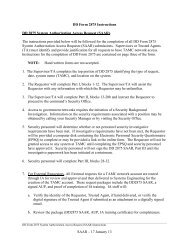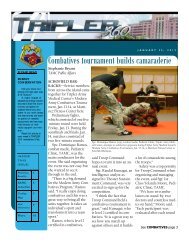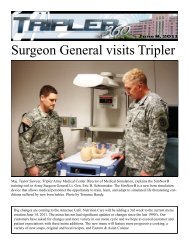here - Tripler Army Medical Center - U.S. Army
here - Tripler Army Medical Center - U.S. Army
here - Tripler Army Medical Center - U.S. Army
Create successful ePaper yourself
Turn your PDF publications into a flip-book with our unique Google optimized e-Paper software.
TRIPLER ARMY MEDICAL CENTER<br />
INTERSERVICE PHYSICIAN ASSISTANT PROGRAM<br />
PHASE 2 TRAINING<br />
ORIENTATION AND POLICY MANUAL<br />
Updated<br />
9 August 2012<br />
1
WELCOME<br />
Welcome to <strong>Tripler</strong> <strong>Army</strong> <strong>Medical</strong> <strong>Center</strong><br />
The attack on Pearl Harbor led to the construction of <strong>Tripler</strong> <strong>Army</strong> <strong>Medical</strong> <strong>Center</strong>. For four years<br />
following the 1941 attack, the patient population at <strong>Tripler</strong> General Hospital at Fort Shafter<br />
remained at approximately 2,000. Today, <strong>Tripler</strong> <strong>Army</strong> <strong>Medical</strong> <strong>Center</strong> is the only federal tertiary<br />
care hospital in the Pacific Basin. It supports 264,000 local active duty and retired military<br />
personnel, their families, and veteran beneficiaries. In addition, the referral population includes<br />
171,000 military personnel, family members, veteran beneficiaries, residents of nine U.S. affiliated<br />
jurisdictions (American Samoa, Guam, and the former Trust Territories), and forward-deployed<br />
forces in more than 40 countries throughout the Pacific. <strong>Tripler</strong> <strong>Army</strong> <strong>Medical</strong> <strong>Center</strong> is the home<br />
of the Pacific Regional <strong>Medical</strong> Command, one of six geographically-based regional medical<br />
commands in the U.S. <strong>Army</strong> <strong>Medical</strong> Command. In addition to <strong>Tripler</strong>, the Pacific Regional <strong>Medical</strong><br />
Command includes Schofield Barracks Health Clinic, <strong>Medical</strong> Activity – Japan, and the provisional<br />
<strong>Medical</strong> Activity – Korea. Soldiers of the Pacific Regional <strong>Medical</strong> Command are deployed in<br />
support of Operation Iraqi Freedom, Operation Enduring Freedom, and throughout the Pacific<br />
Theater.<br />
The Staff at TAMC is committed to your training and developing you to be a competent Health<br />
Care Provider, PA, and Officer. You will be challenged while <strong>here</strong>, both mentally and<br />
physically. We are not training you to be a PA in a Battalion Aid Station (BAS); we are training<br />
you to be a PA for Life. The <strong>Army</strong> program is much different from civilian PA schools and the<br />
expectations of an <strong>Army</strong> PA are much higher. We will prepare you for the challenges to come.<br />
You must prepare yourself, study, and be on your toes at all times. Any student who is not<br />
motivated to do their part or complete the mission will find it hard to succeed.<br />
This guide was prepared to assist you in your transition from Phase 1 at Fort Sam<br />
Houston to Phase 2 at <strong>Tripler</strong> <strong>Army</strong> <strong>Medical</strong> <strong>Center</strong>. In this guide you will find answers to<br />
questions that were asked by students preceding you. Read through the entire guide, print it and<br />
have the final page signed for me to collect when you in process. Remember, this guide is just<br />
that, a guide. In the absence of specific guidance, use common sense and good judgment with<br />
above all, integrity. Never be afraid to ask questions!<br />
YOUR ASSIGNED SPONSOR is MAJ Stewart Miller<br />
Stewart.miller@amedd.army.mil or TAMC.EDIPAP@amedd.army.mil<br />
2
ORIENTATION<br />
Your first week will be used to in-process yourself with the program and to settle your families<br />
to the island of Oahu. The second and third weeks will be completion of in-processing, Hospital<br />
Orientation and Hospital training (AHLTA, CHCS, DMHRSi , T-system (ED)). It is crucial that<br />
you follow your specific in-processing schedule in order for you to be able to see patients during<br />
your first clinical rotation. You will receive your in-processing checklist and schedule upon day<br />
1 of your arrival to Phase 2. You will report NLT 6 May to Delta Company. The following<br />
morning (7 May) you will report to the Emergency Department Conference Room. Your Sponsor<br />
(CPT Gomez) will meet you outside and guide you in. Spouses are an integral part of the support<br />
network that has allowed each student to progress to the Phase 2 level. Phases 1 and 2 have<br />
similar goals for training, but the approach and philosophy of student instruction is completely<br />
different. Phase 2 requires a great deal of self-motivation and study. This activity prepares the<br />
PA student for a life of professional enrichment by self-directed study. The transition from<br />
student to professional provider begins with the orientation.<br />
Some of your orientation will be conducted by course personnel and will include<br />
integration into the clinical aspects of training. Other training requirements include local<br />
facilities and policies, standards of performance, staff responsibilities, and health care<br />
professional training including Defense <strong>Medical</strong> Human Resource System- internet (DMHRSi),<br />
Composite Health Care System (CHCS) and Armed Forces Health Longitudinal Technology<br />
Application (AHLTA), review of My Evaluations and UNMC Blackboard. Training such as<br />
Basic Life Support (BLS) and Advanced Cardiac Life Support (ACLS) will be scheduled by the<br />
IPAP TAMC Administrator prior to or upon your arrival to Phase 2.<br />
SIGNING IN AND IN-PROCESSING<br />
Follow the below link and make yourself aware of the nuances about PCS moves to Hawaii. Pay<br />
close attention to the TLA. T<strong>here</strong> are many locations for you and your family to stay. <strong>Tripler</strong> has<br />
guest housing options and t<strong>here</strong> are many other locations on the island. However, if<br />
driving/traffic is not an issue for you, I recommend staying at the Hale Koa Hotel downtown<br />
Waikiki (on the beach) until you find the housing you desire, as this will allow any family<br />
members to quickly become accustomed to their new surroundings---THE BEACH!<br />
http://www.tamc.amedd.army.mil/arrivals/newarrivals.htm<br />
You will be signing into <strong>Medical</strong> Company D, <strong>Tripler</strong> <strong>Army</strong> <strong>Medical</strong> <strong>Center</strong><br />
In the event of after hour questions you should contact the CQ desk- (808) 433-1930.<br />
The IPAP Administrative Assistant is Ms. Grace Ho. She is the Emergency Department<br />
Administrator. You will meet her on day one of in-processing. She is a huge supporter of the<br />
program and helps the program tremendously.<br />
YOUR ASSIGNED SPONSOR is MAJ Stewart Miller<br />
Stewart.miller@amedd.army.mil or TAMC.EDIPAP@amedd.army.mil<br />
3
MEDICAL CHAIN OF COMMAND<br />
Hospital Commander<br />
Deputy Commander for Clinical Services<br />
Phase 2 <strong>Medical</strong> Director<br />
Phase 2 Clinical Coordinator (Military)<br />
Phase 2 Clinical Coordinator (Civilian)<br />
BG Dennis Doyle<br />
CAPT Andrew Findley<br />
CAPT Kenneth Kelley, MD<br />
MAJ Stewart L. Miller, APA-C, MPAS<br />
Mr. Rocco Laudadio, PA-C, MPAS<br />
ADMINISTRATIVE CHAIN OF COMMAND<br />
D. Company Commander CPT Vanessa Mayo<br />
D. Company First Sergeant 1SG Natasha Looper (Outbound summer 12)<br />
Phase 2 Coordinators<br />
MAJ Stewart Miller, APA-C<br />
Mr. Rocco Laudadio, PA-C<br />
MAIL/MESSAGES<br />
Your official mailing address is:<br />
<strong>Tripler</strong> <strong>Army</strong> <strong>Medical</strong> <strong>Center</strong><br />
Attn: MCHK-ED<br />
Interservice Physician Assistant Program<br />
1 Jarrett White Road<br />
<strong>Tripler</strong>, HI 96859-0000<br />
Once you have an established <strong>Tripler</strong> Outlook account. I will expect a minimum of 3<br />
checks of e-mails per day (First thing in the Morning, Lunch and prior to leaving for the day).<br />
Pass along information to each other as appropriate, without back and forth arguments.<br />
EQUIPMENT<br />
You will need your own stethoscope upon arrival to TAMC. A laptop computer and<br />
pager will be issued to each of you. I would recommend that you have at a minimum the<br />
Tarascon Pocket Pharmacopoeia and The Sanford Guide to Antimicrobial Therapy and a pair of<br />
shoes dedicated for use at the hospital while wearing scrubs. You will be issued a lab coat and<br />
scrubs. You will have a study/research area that is assigned to the PA program you may store<br />
your personal items, but never sleep t<strong>here</strong>. It will be your responsibility to keep your areas clean.<br />
DUTY UNIFORM<br />
The clinical rotation or work location determines the duty uniform. While most of the<br />
population has a cell phone, we cannot make you carry one at all times. However, the pager you<br />
will be issued is a part of your uniform on a daily basis. Hospital policy dictates that you must<br />
wear a uniform when coming to and from duty; you can wear either the PT uniform or ACUs.<br />
Typically, the <strong>Army</strong> Combat Uniform (ACU) or scrubs are authorized in your rotations. The<br />
4
white lab coat will be worn while seeing patients or as dictated by your preceptor. The TAMC<br />
Hospital ID badge will be furnished and worn at all times while on duty in the hospital or any<br />
outlying clinics. The badge will be worn on the left side just below the US ARMY name tape.<br />
Hospital scrubs are only authorized when performing duties in the rotations requiring their use.<br />
Privately owned scrubs will not be worn. During these rotations, if you must leave the area,<br />
cover the scrubs with your white coat. Scrubs are not authorized outside the hospital. During<br />
recall, the duty uniform is the ACU. MEDCOM patches and TAMC unit crests are authorized<br />
on the uniforms; National Guard may continue to wear their unit patch.<br />
DUTY HOURS<br />
Duty hours are rotation and clinical preceptor dependent. Hours may be adjusted to<br />
spend additional time in rotations to meet the objectives of each clinical area. Students are<br />
expected to make ward rounds and take call with their preceptor that may require early morning<br />
or nights. Generally, expect to spend 50 hours per week at a minimum in the hospital during<br />
regular duty hours, anticipate 5 hours in the ER after hours and 6 hours on the weekends.<br />
Anticipate 10-20 additional hours per week in self-study. T<strong>here</strong> may be times that you may<br />
have to stay beyond the schedule such as disasters and MASCAL events.<br />
ABSENCES<br />
Students are required to obtain a signed approval from their preceptor when he/she will<br />
be absent from the clinic for more than 2 hours. This request is then forwarded to the Clinical<br />
Coordinator who will remain the approval authority for all clinic absences. You must notify me<br />
of any absences of less than 2 hours via email in order to keep a record of your clinical hours.<br />
ON CALL DUTY<br />
Performing call is an integral part of the student education. Students may be required to<br />
pull call in any rotation as directed by their preceptors. During certain rotations, you will be<br />
removed from the ER schedule because of the demanding hours. You must return all<br />
pages/calls within 5-10 minutes and report to the designated area within 30 minutes. No<br />
exceptions! Your preceptor will determine post call activities as appropriate.<br />
SICK CALL<br />
Sick call is conducted at the Internal medicine Clinic for assigned military staff. IM clinic<br />
is located on the 3 rd Floor (Mountain Side) adjacent to ED. Sign in begins at 0700 hours. If you<br />
are due to be on shift and are ill before they are open, contact the Phase 2 coordinator, your<br />
preceptor, and class leader. T<strong>here</strong> is no excuse for not providing notification if you are ill.<br />
KEY AND ESSENTIAL PERSONNEL<br />
Despite wearing the uniform you are NOT considered key or essential personnel. You<br />
are considered a student in training and t<strong>here</strong>fore not required to report to work when only key or<br />
essential personnel are to report for duty. Normally this applies to inclement weather situations.<br />
5
I will call you and advise you if your help is needed at the hospital. Otherwise these days are<br />
considered self study at home.<br />
TAMC IPAP SHAREPOINT<br />
This website will be provided to you during your in-processing and is only available on<br />
TAMC computers. This is w<strong>here</strong> we will post everything related to IPAP Phase 2 TAMC- such<br />
as announcements, Calendar (including ER schedule, meetings, and presentation), learning<br />
objectives, and preceptor information. You will be required to check your e-mail and this site<br />
at least once daily. I recommend that you make it your homepage. You will be responsible for<br />
all information that is put on this site. Ignorance is not an excuse for non-compliance. If you<br />
have questions or concerns regarding the SharePoint site or other information please let us know<br />
immediately.<br />
LECTURES/MEETINGS<br />
Lectures and training events are scheduled throughout the year on a variety of topics and<br />
attendance is mandatory. These events are scheduled every Wednesday throughout the entire<br />
year. Any and all absences from Wednesday events must be cleared through the Phase 2<br />
Coordinator. The lectures are an important aspect of the Phase 2 educational process and should<br />
not be dismissed. The following is the current lecture schedule:<br />
Testing hours: Wednesdays 0800-1000 hours<br />
PA Coordinator Meeting: Wednesdays from 1000-UTC (you will not be required to<br />
return to your rotations on that day)<br />
Clinic Level Training: clinic dependent, you may be required to present topics for<br />
discussion<br />
Hospital CME: Varies<br />
Some Wednesday events may include Coordinator time that will be for off campus<br />
events: Jump TOC meetings/Journal Club/Educational training event or a training event<br />
with another institution.<br />
LIBRARY<br />
The hospital <strong>Medical</strong> Library is available for student use at all hours. Students have the<br />
same access, checkout privileges and responsibilities as other hospital personnel. Please follow<br />
the rules regarding the library so that we may keep these privileges. Specific texts related to the<br />
rotations and end of rotations examinations are available at the library.<br />
LEAVE POLICY<br />
Students may take two weeks of ordinary leave during the Christmas holidays. T<strong>here</strong><br />
will be opportunities for additional leave placed into your clinical rotation schedule. If you are<br />
in a “use or lose” situation, t<strong>here</strong> are no mechanisms to carry excess leave over to the next year if<br />
that leave exceeds the time allotted during training. Consult the Phase 2 Coordinator concerning<br />
all matters of leave. For emergency leave, contact the Phase 2 Coordinator who will work on<br />
contacting the <strong>Medical</strong> Company 1SG or Commander as soon as possible. You may only take a<br />
6
pass during TAMC training holidays or federal holidays. You will not take a pass if your<br />
preceptor requires you to work or you are on call. All leave requests must be approved by the<br />
Phase 2 Coordinator and turned into the Company not less than 30 days prior. All leave or pass<br />
requests will be approved or disapproved by the Phase 2 Coordinator and likely not granted if<br />
you are on academic or non-academic probation (situational). All students going on pass and<br />
leave must complete all TES requirements and required forms and will sign in and out IAW<br />
TAMC Policy. Your leave is already preplanned based on clinical rotations. We will consider<br />
exceptions to the preplanned leave for time sensitive events (weddings, births, etc.). These will<br />
be on a case-by-case based on academic standing since leave is a privilege.<br />
PHYSICAL FITNESS/WEIGHT CONTROL<br />
All students are responsible for maintaining appropriate level of physical fitness and<br />
weight. The program requires you successfully pass 2 <strong>Army</strong> Physical Fitness Test (APFT)<br />
during your Phase 2 training. The Delta Company APFT is administered in April and October<br />
and always subject to change, attendance is mandatory. Students with illness/injury that may<br />
prevent them from passing the APFT must document the illness/injury and receive appropriate<br />
duty modification (profile). DO NOT wait until just before the APFT to do this. Failure to pass<br />
the APFT or Ht/Wt is cause for non-academic probation. It will also trigger mandatory physical<br />
fitness training sessions. You are required to take another APFT within 30 days of attending<br />
BOLC, so some will take a third APFT (this one does not affect the program/graduation).<br />
OFF-DUTY EMPLOYMENT<br />
Off duty employment is NOT authorized. NO exceptions!<br />
PHYSICIAN ASSISTANT NATIONAL CERTIFICATION EXAMINATION (PANCE)<br />
Certification through the National Commission on Certification of Physician Assistants<br />
(NCCPA) is required within two testing opportunities. I will notify you when you are eligible to<br />
register for testing which will be approximately 3 months prior to graduation. At that point you<br />
may contact NCCPA online at www.nccpa.net to register. T<strong>here</strong> is a 7-day waiting period after<br />
your graduation date. Pay attention to deadlines and requirements in the test announcement.<br />
Failure to complete requirements in a timely manner will result in unnecessary delays in testing<br />
and certification. You will pay out-of-pocket for your test however you’ll be reimbursed after<br />
you receive your grade so be sure to keep your receipt of payment.<br />
COMMISSIONING<br />
For the officer candidates, this is an important event in the life and career of each<br />
individual and it should be treated accordingly. I have outlined what is expected of a basic<br />
graduation ceremony. The class will decide the specifics of this ceremony, pending approval of<br />
the Phase 2 Coordinator and the CSM. The class is responsible for costs (if any) for graduation<br />
(e.g. reception cost, cake, etc).<br />
Prior to Commissioning: Obtain all uniform items well in advance of the commissioning<br />
ceremony. Clothing Sales has rank and uniforms, but often must special order SP corps badges<br />
7
and unit patches. A pre-graduation uniform inspection will take place 30 days prior to<br />
graduation and will be held by the Class Leader or other student as delegated by the leadership<br />
Commissioning Physicals: Your commissioning physical must be initiated 3 months prior to<br />
graduation and at least 6 months if you need flight status physical or require waivers.<br />
Once Commissioned: Request new ID cards for yourselves and family members on day of<br />
commissioning. AG will need documentation of dependency for re-enrollment in DEERS.<br />
Carry marriage, birth, adoption records, etc. Do not allow these documents to be packed with<br />
your household goods.<br />
PCS ORDERS<br />
The Phase 2 Coordinator will conduct all correspondence regarding PCS orders on the<br />
student’s behalf. Normally, 3-6 months prior to graduation, HRC will contact each Phase 2<br />
Coordinator with a list of potential assignments. Future graduates will provide their preferences<br />
and special considerations (joint domicile, EFMP, family member illnesses, etc.) to the Phase 2<br />
Coordinator for forwarding to HRC. DO NOT contact HRC yourself, this is strictly<br />
prohibited. You may request exception to this rule by the Phase 2 Coordinator only.<br />
Assignment personnel (HRC) attempt to meet individual desires, but the needs of the <strong>Army</strong><br />
always come first. The assignment process is not intended to be impersonal and regimented.<br />
ROTATION TRAINING GOALS<br />
At least one week prior to each rotation, students will report to the preceptor of that<br />
service or clinic and discuss the dates of your rotation, reading requirements, and their<br />
expectations. Ask the NCOIC or Head Nurse to give you a quick orientation of their clinic on<br />
the first day of your rotation to include crash cart/AED and fire equipment location—prior to<br />
performing any clinic duties. Once you are in the service, do not wait for someone to tell you to<br />
pull a chart; ask the preceptor what is expected. For example, you may ask, “Should I begin by<br />
seeing patients or by shadowing you first?”<br />
PHARMACY, LAB, & RADIOLOGY ORDERS<br />
Students will not independently write prescriptions or possess pre-signed prescriptions.<br />
The preceptor must co-sign all student prescription orders. AHLTA/CHCS1 access will allow<br />
you to order prescriptions under your preceptors name however these medications will not be<br />
dispensed until your preceptors sign off of the prescription in the AHLTA/CHCS 1 system. You<br />
are authorized to order radiological and laboratory studies under your preceptors name as well.<br />
You must clarify your preceptors comfort level with allowing you to input any orders prior to<br />
entering any orders under their name.<br />
8
WEEKLY EVALUATIONS<br />
Your weekly progress is monitored by your preceptor and should be documented on a<br />
weekly evaluation form. This serves to inform you and the Phase 2 Coordinator of your progress.<br />
These evaluations are a direct reflection of your performance and a good predictor of your<br />
rotation grade.<br />
PERFORMANCE EVALUATIONS<br />
The preceptor for each rotation will be required to complete a Performance Evaluation on<br />
http://www.myevaluations.com during your last week of every rotation. This evaluation counts<br />
for 75% of your rotation grade. On a case by case basis a preceptor may be asked to complete<br />
the Performance Evaluation reflecting a passing grade before the student may take the written<br />
exam.<br />
CRITIQUES<br />
Student critiques are an important element of Phase 2. We provide students opportunities<br />
to express opinions, suggestions, or concerns about any aspect of the Phase 2 training. We take<br />
all comments, positive and negative, seriously and endeavor to continually improve the program.<br />
End-of-rotation critiques will be turned in with your performance grade. They are reviewed by<br />
the clinical coordinators and the preceptors. Ensure you make honest and defendable statements.<br />
TESTING<br />
The rotation grade is derived from clinical performance rating (75%) and a written<br />
examination (25%), both of which must equal at least 75%. You must successfully complete the<br />
clinical portion and have all of your evaluation forms completed and signed by the rotation<br />
preceptor. New tests have been published and all tests are 60 question tests with the exception of<br />
Internal Medicine and Family Practice which are 100 question tests. You will have 75 minutes<br />
to take the 60 question tests and you will have 2 hours to take the 100 question tests. Each test<br />
contains multiple choice questions and is based on the rotation’s objectives and reading list.<br />
Written references from your reading list are required to argue a test question. The maximum<br />
score you can receive on a retest is 75%. Testing will take place on the last Wednesday morning<br />
of your rotation; however, you may take your test as early as a week prior and no later than a<br />
week after your rotation. You will be sent back to your rotation after the test and you'll be<br />
excused at 1300 if you pass the test. If you do not pass the test you will stay at your rotation for<br />
the remainder of the day and you will lose this privilege since you will be on academic<br />
probation. You will take the retest in 5-10 days however under no circumstances will you take<br />
the retest earlier than 5 days. Needless to say, if you are on academic probation you will not be<br />
awarded time off after any test until probation has been lifted (typically 60 days).<br />
READING LISTS AND OBJECTIVES<br />
Rotation objectives for Phase 2 will be provided for you at the end of Phase 1. If you do<br />
not have a copy, a copy is retained on file with the IPAP Coordinators and University of<br />
9
Nebraska <strong>Medical</strong> <strong>Center</strong> (UNMC) Blackboard .These objectives provide a cognitive framework<br />
for study and help focus the study in preparation for the examination. The study of medicine<br />
however, cannot be completed within the allotted time, no matter how diligent you are. As a<br />
professional, you must continue to pursue knowledge as long as you practice.<br />
ROTATIONS<br />
INTERNAL MEDICINE/NEUROLOGY (6 weeks): PA students are exposed to all<br />
subspecialties in Internal Medicine and see a variety of patients. PA students are also exposed to<br />
a variety of diagnostic procedures. You obtain skills in history and physical examination<br />
including admission history and physical. Instruction in problem oriented medical record<br />
maintenance and oral presentation is emphasized. You will develop a working knowledge for<br />
protocols in patient evaluation and management. Appropriate utilization of ancillary services<br />
including laboratory and x-ray are emphasized. Students learn limitations and appropriate<br />
indications for immediate and delayed consultation. Management techniques for chronic<br />
illnesses, polypharmacy, multiple problem patients, and the terminally ill are encountered. The<br />
student will perform five weeks of Internal Medicine one week of Neurology at TAMC. While<br />
on the ward, the PA student functions as a member of the health care team and learns appropriate<br />
interactions and complementary functions of its various aspects. The PA student is required to<br />
stay in-house when their preceptor is on 24-hour duty.<br />
DERMATOLOGY (4 weeks): Students are exposed to a wide range of dermatological conditions<br />
and learn to recognize and manage them. Technical training includes obtaining tissue scrapings,<br />
shave biopsy, patch testing, KOH preps, use of a Wood’s light, and skin therapy with liquid<br />
nitrogen. Assisting with and performing outpatient minor surgery using techniques and<br />
procedures that are necessary for success as a primary provider are emphasized.<br />
DERMATOLOGY TIPS<br />
Dermatologic conditions are among the top reasons for patient visits to primary care<br />
facilities. A strong foundation of knowledge in the diagnosis and treatment of common skin<br />
disorders is t<strong>here</strong>fore an essential component of your clinical training.<br />
In order to get the most from your time with Dermatology you will need to do a great<br />
deal of reading. As a minimum, you will need to thoroughly familiarize yourself with the<br />
conditions listed under learning objectives in this handout. It is strongly recommended that you<br />
obtain a good basic dermatology text. “Color Atlas and Synopsis of Clinical Dermatology” by<br />
Fitzpatrick and “Clinical Dermatology: A Color Guide to Diagnosis and Therapy” by Habif are<br />
both excellent basic references for primary care, and each has a section on the proper<br />
dermatologic terms for description of skin lesions. These texts are available in the <strong>Medical</strong><br />
Library, however you are strongly encouraged to purchase them for your personal library. The<br />
e-Medicine Online Textbook of Dermatology is also an excellent reference available free online<br />
at www.emedicine.com. Another free resource is the online atlas of dermatology available<br />
through Johns Hopkins University at www.dermatlas.org. This website also has a selfdiagnostic<br />
photo quiz.<br />
10
PEDIATRICS (5 weeks): Students receive exposure and training in general pediatrics through<br />
involvement with the clinic, nursery, and inpatient services. The student will perform 5 weeks of<br />
both inpatient and outpatient rotations at TAMC or Schofield Barracks. The nursery provides<br />
intense exposure to newborn assessment and physical examination skills. Neonatal resuscitation<br />
in the nursery and delivery room is included. Inpatient services enhance the complete pediatric<br />
history and physical examination skills. Further training in prescribing and drug administration<br />
is included in the clinic setting. Parent and patient education, safety, child development, and<br />
poison control issues are addressed in the clinic through involvement with all practitioners.<br />
OBSTETRICS AND GYNECOLOGY/LABOR AND DELIVERY (4 weeks): PA students<br />
receive experience with inpatients and outpatients through the clinic, ward, and labor & delivery.<br />
Extensive training in routine pelvic examinations is essential for helping each student<br />
differentiate normal anatomy from pathology. Such training is essential for the evaluation of<br />
abdominal pain in the female patient. Each student will become familiar with pre and post-natal<br />
care and examination. A working knowledge of birth control methods, pre and post-menopausal<br />
hormone therapy, routine health maintenance, evaluation of vaginitis, and abnormal menses are<br />
essential. While t<strong>here</strong>, you are required to perform routine deliveries under the supervision of<br />
your preceptor. A Terminal Learning Objective is for the student to perform a Delivery however<br />
don’t expect to deliver a baby unless you are actively working with the nurses who are following<br />
the patient from active labor through delivery with the physician or midwife. You will greatly<br />
enhance the training and skills required in emergency situations that you may encounter in the<br />
community and during deployment. Labor and delivery instruction includes use of fetal<br />
monitors and equipment. Each student is required to pull call with their preceptor including<br />
working in labor & delivery.<br />
During this rotation you are required to pull call and remain in the hospital overnight<br />
every third night starting with the first night of the rotation and ending the morning of the 23 nd<br />
day of the rotation. You will report to the on call OB/GYN provider at the beginning of the day<br />
and advise them that you are on call with them through the next morning. If you are actively<br />
involved in patient care and get little to no sleep that night while on call, you may observe post<br />
call privileges as determined by your preceptor. You must notify the Phase 2 coordinator before<br />
you leave the hospital if you are given post call privileges. You will be off of the ER schedule<br />
during your OB rotation.<br />
PSYCHIATRY (3 weeks): The Behavioral Medicine Division (BMD) will provide you exposure<br />
to a variety of common mental health problems in the inpatient and outpatient settings. Students<br />
learn comprehensive history taking, mental status examination, and how to interact with<br />
potentially unstable patients. Students learn from several disciplines, including psychiatry, social<br />
work, and child advocacy while participating in family therapy and group dynamics. The<br />
rotation is divided so each student can spend some time in each aspects of behavioral medicine.<br />
You should do at least one intake history.<br />
PSYCHIATRY TIPS<br />
Know the differences between the Axis prior to your rotation. Know the general types of<br />
drugs and what they are used to treat.<br />
11
GENERAL SURGERY (5 weeks): Students are exposed to inpatient and outpatient surgical<br />
patients and procedures. Training in complete surgical histories and physical examination<br />
techniques are covered. You receive training in emergency patient management and appropriate<br />
referral of surgical patients. Students pull call and attend surgical cases with the preceptor.<br />
Students participate with pre and post-op surgical care. Opportunities to perform minor<br />
outpatient procedures routinely accomplished by PAs are provided.<br />
ORTHOPEDICS/ /PT/OT/ PODIATRY (6 weeks): Inpatient and outpatient experiences ensure<br />
students can accomplish a complete and appropriate orthopedic history and comprehensive<br />
examination. Application of splints, casts, orthotic devices, traction, and local anesthetics are<br />
part of the skills training. Students will pull call with the preceptor. Students observe and<br />
participate in surgical procedures to the extent of their skills and cooperatively manage<br />
inpatients. This rotation will include five weeks of Orthopedics/PT/OT and one week of<br />
Podiatry. You will become seasoned in performing physical exam techniques and therapies you<br />
will use throughout your career. No student should have any time that they are not engaged in<br />
patient care.<br />
ORTHO TIPS<br />
Prior to this rotation, students are expected to have a basic understanding of<br />
musculoskeletal anatomy as well as history and physical exam techniques specific to<br />
Orthopedics. This rotation is a hands-on learning experience and it is up to the student to take<br />
the initiative to see patients, write notes and present patients to the staff as well as ask questions.<br />
Taking an observational approach during this rotation will not be beneficial to the student and<br />
will result in less than a passing grade. An excellent reference book for the rotation is<br />
“Essentials of Musculoskeletal Care” by the American Academy of Orthopedic Surgeons; this<br />
text is available in the medical library however you are strongly encouraged to purchase this for<br />
your personal library. Another recommendation is “Netter’s Concise Atlas of Orthopedic<br />
Anatomy: by Jon C. Thompson; this text is NOT available in the library however if you don’t<br />
have an anatomy book, or even if you do, this is the one to purchase. Another excellent<br />
reference recommended by Ortho is the website www.wheelesonline.com<br />
OTORHINOLARYNGOLOGY/ALLERGY (4 weeks): Various ENT conditions, their<br />
recognition, and common management principles are covered. Students obtain skills in use of<br />
ENT microscopes, special equipment, headlamps, diagnostic techniques, tympanometry, and<br />
direct and indirect visualization procedures. Principles and guidelines for referral are covered.<br />
Observation and participation in ENT surgical procedures, patient evaluations, and call with their<br />
preceptor is expected.<br />
OPHTHALMOLOGY (2 weeks): Students receive exposure to acute and chronic eye diseases<br />
relative to primary care and emergency room care. Training is included in physical diagnosis,<br />
management of common eye disorders, and guidelines for referral or consultation. The student<br />
should develop reasonable proficiency in use of the slit lamp and tonometry. Students are<br />
expected to pull call with the preceptor and observe surgical procedures. Assistance with<br />
procedures is dependent on student skills and at the discretion of the preceptor.<br />
12
FAMILY PRACTICE/LONG TERM CARE (4 weeks/1 week): This rotation is scheduled to<br />
allow as much time with the preceptors when medical students are not rotating in the clinic. You<br />
will rotate at either TAMC or Schofield Barracks. Outpatient examinations will exhibit some<br />
shift to problem focused evaluation in contrast to the comprehensive nature of examination skills<br />
acquired during the medicine rotation. The ability to select the appropriate skills to apply from a<br />
repertoire gained during prior clinic rotations is felt essential to the success of a practicing PA.<br />
Your clinical grade will consist of FP (80%) and LTC (20%).<br />
EMERGENCY MEDICINE (2 weeks + 160 hours minimum): The emergency medicine<br />
experience is a requirement that occurs concurrently with other rotations. Each student will<br />
work a solid two-week rotation, (100 hrs) in the ER and complete a minimum of 160 hours<br />
during the after hours in the Emergency Department to meet graduation requirements. You will<br />
be working above and beyond the additional 160 hours and you will pull approximately 200-250<br />
hours. This site specific requirement which will aid in your development as a competent, well<br />
trained PA.<br />
Preceptors are required to certify that the student was present for the entire shift. Your<br />
daily progress in the ER during the year is monitored and documented by your preceptor. You<br />
will continue to pull ER rotations throughout the entire year. The freshman will have directed ER<br />
schedules. Juniors will have little directed ER hours. Seniors will have no directed schedule<br />
pertaining to the ER required hours. The seniors will schedule themselves as seen fit based on<br />
needs and openings.<br />
On weekdays your shift will begin at 1700 hours and last until 2200 hours depending on<br />
your ER preceptor and current situation while you are on shift (e.g. MASCAL, specific trauma or<br />
patients that your preceptor deems necessary for you to see, etc). You may start your time in the<br />
ER no earlier than 1600 if you have been released by your rotation preceptor for that day. If you<br />
have been released by your preceptor prior to 1600 hours, you will NOT leave the facility; you<br />
have several options such as self study in the Library or Student classroom and work in any other<br />
rotation already passed. When in doubt, ask the Phase 2 coordinator; other arrangements will be<br />
made on a case by case basis. Those scheduled to work on the weekends the time is your times<br />
will be in two shifts to allow for family time. Weekends consist of 06-1200 and 1200 to 1800.<br />
Despite the dictated time, it is your responsibility to keep track and log your hours. Ensure that<br />
you spend time with a variety of providers in the ER and avoid sticking to one preceptor.<br />
ER TIPS<br />
Several important policies will be covered during your ER orientation however, <strong>here</strong> are the<br />
basics:<br />
Students will NOT work independently.<br />
The preceptor WILL see all patients and co-sign the ER record prior to disposition.<br />
Students may NOT have pre-signed prescriptions or independently dispense drugs from<br />
the MOD cabinet.<br />
The shift will be a 5 hour shift on the weekday evenings or a 5-10 hour shift on the<br />
weekends. Weekend hours includes breaks and lunch. During the evening shift it is for 4<br />
hours straight without a break. Eat your dinner prior to your rotation. If you determine<br />
you need a break for dinner ensure that time is made up at the end of your shift.<br />
The primary reference for your training rotation <strong>here</strong> will be:<br />
Emergency Medicine: A comprehensive Study Guide, by Tintinalli, Judith E.<br />
13
RADIOLOGY Required Elective (1 week): This rotation is intended to teach students of the<br />
fundamentals of reading plain films that are most commonly used in the TMCs. The student<br />
spends time reviewing films with a radiologist one on one. This is a "pass" or "fail" rotation.<br />
ELECTIVES (Allowed 3, 1 week each): 2 weeks are chosen for you (Family Medicine and<br />
TMC), the other week is your choice and is scheduled at the end of your year. This elective will<br />
be approved by the Clinical Coordinator.<br />
MASTER’S PAPER Your Master’s Research Paper should have been completed and graded in<br />
Phase 1. You will email the Phase 2 coordinator (MAJ Miller & Mr Laudadio) the grade (if<br />
known) and a copy of your paper in order to determine the proper mentor for your Master<br />
Presentation.<br />
STUDENT ORAL PRESENTATIONS (3): All presentations will be on Power Point with<br />
objectives. The first page will be a title page, then Objectives, then the body of the presentation<br />
which will correspond with the objectives, and then the final page which will be the references.<br />
You will be notified once you have met your time limit. You will not go over 5 minutes past the<br />
allotted time and will be asked to stop at that point. You will not receive credit for any portion of<br />
the presentation you are delinquent on. You will provide the presentation in handout form for the<br />
audience. You are encouraged to practice your presentations to the Phase 2 coordinator and/or<br />
class at least one week prior to the graded event.<br />
1. Master’s Presentation (Senior Phase)- You will be assigned a mentor/subject-matterexpert<br />
for your topic that will assist you in fine tuning for your presentation. This<br />
presentation will summarize your research paper and last 30-45 minutes. You will<br />
prepare a, flyer and a poster for this presentation. This presentation will be open to all<br />
hospital staff members who want to attend and will take place in a formal presentation<br />
setting. Uniform when presenting is ASU/Class A (if you still own them) with your<br />
mentor, medical director and Phase 2 coordinator for grading.<br />
2. <strong>Medical</strong> Topic of Personal Interest (Junior Phase)- All medical topics are applicable<br />
and should not have been presented by a fellow student currently at this site. It should<br />
last 20-30 minutes and include a follow on Simulations Lab.<br />
3. Professional Topic (Military or Professional interest)– This topic is not simply a<br />
medical topic, but can be a professional topic of significance to military PAs. The<br />
actual presentation should be no more than 30 minutes. You are expected to “think<br />
outside the box” which may mean selecting a location outside of the classroom or even<br />
outside of the hospital (e.g. simulation training center, procedure room or office,<br />
bringing training aids and equipment, etc.)<br />
YOUR ASSIGNED SPONSOR is MAJ Stewart Miller<br />
Stewart.miller@amedd.army.mil or TAMC.EDIPAP@amedd.army.mil<br />
14
PHASE 2 COORDINATOR<br />
“PET PEEVES”<br />
1. Tardiness (without excuse)- Circumstances do arise<br />
2. Disrespect- to any individual regardless of rank or status/capacity<br />
3. Lying- This will never be tolerated!<br />
4. Uniformity- Everyone <strong>here</strong> is an adult and expected to be in the right place at the right<br />
time (early), and in the right uniform.<br />
CONCLUSION<br />
These rules were established for the protection of all – the student, patient, and hospital.<br />
FOLLOW THEM WITHOUT DEVIATION.<br />
Anytime a student is placed in an uncomfortable or compromising situation, regardless of<br />
the rotation, he/she should notify the Phase 2 Coordinator immediately.<br />
Reading is the best thing you can do for yourself. You are in charge of your learning. If<br />
you read BEFORE going to your next day's clinic, you will better understand what you<br />
are seeing. You will be more articulate with your preceptor and learn more.<br />
The preceptor is t<strong>here</strong> to challenge and teach you specific techniques and pearls. If you<br />
choose not to come prepared, the preceptor may (and often does) leave you to yourself.<br />
Be prepared to be a considerate, but aggressive self-starter and learner.<br />
Along with becoming a medical provider, many of you are becoming an Officer in the<br />
United States <strong>Army</strong>. You are expected to carry yourself with the utmost integrity and<br />
selflessness. You must strive for the highest levels of excellence. Speak kindly and<br />
considerately with every person you meet. You can learn something from everyone<br />
within the realm of their credentials. Listen and learn! Lead by example. Thank those<br />
around you and be helpful when appropriate.<br />
Respect others and conduct yourself with dignity. Do not discriminate against or harass<br />
anyone. The most common reason students are removed from the program is<br />
nonacademic. Good luck with your training <strong>here</strong>. Become an adult learner as soon as<br />
possible. It will greatly aid your education.<br />
This is your training. BE PROACTIVE and engage yourself. Tactfully work your way in<br />
and DO NOT get pushed out by others. Jump in neck deep and elbow your way into some<br />
good training. You’ll get good training if you put in the effort. Sit back and you will not<br />
have the same hands on skills as others.<br />
*******NOTE********<br />
We expect each of you to know your schedule, stay ahead of the game on your studies<br />
and above all enjoy the island of Hawaii with your family and friends. In order to truly<br />
enjoy paradise worry free, you will need to stay in good academic standing. Having said<br />
that, do not expect this Phase 2 to be the same as your friends at other sites. T<strong>here</strong> are<br />
many different approaches to accomplish the same goal. Your schedule of rotations and<br />
leave are mandated and some of your electives are chosen for you. The flow of your<br />
rotations may be very different from other sites. T<strong>here</strong> is always a complaint that “Site X<br />
does it this way or gets to do that”. Bottom line- avoid being dragged into how another<br />
site accomplishes its goals of training and what they do versus what you are doing at<br />
15
<strong>Tripler</strong> <strong>Army</strong> <strong>Medical</strong> <strong>Center</strong>. I guarantee you are receiving the exact same training<br />
requirements as your friends while living in paradise.<br />
PRINT AND SIGN THIS DOCUMENT AND HAVE IT WITH YOU DURING<br />
INPROCESSING FOR SUBMISSION INTO YOUR PHASE 2 STUDENT 6-SIDED<br />
FOLDER.<br />
I, (Name)________________________________ have read the Student Orientation Guide for<br />
<strong>Tripler</strong> <strong>Army</strong> <strong>Medical</strong> <strong>Center</strong> Phase 2 PA Student Training (updated 01 JAN 2012). I have been<br />
given the opportunity to ask questions and I do not have any questions regarding the contents of<br />
this manual or any questions of what is expected of me during Phase 2. I understand that I am<br />
accountable to the contents of the manual. I have been given a copy of this manual and I<br />
understand a current copy is also available for reference on the TAMC IPAP Share Drive.<br />
Signature_______________________________ Date_________<br />
Phase 2 Coordinator ___________________________________<br />
Phase 2 Coordinator ___________________________________<br />
16


